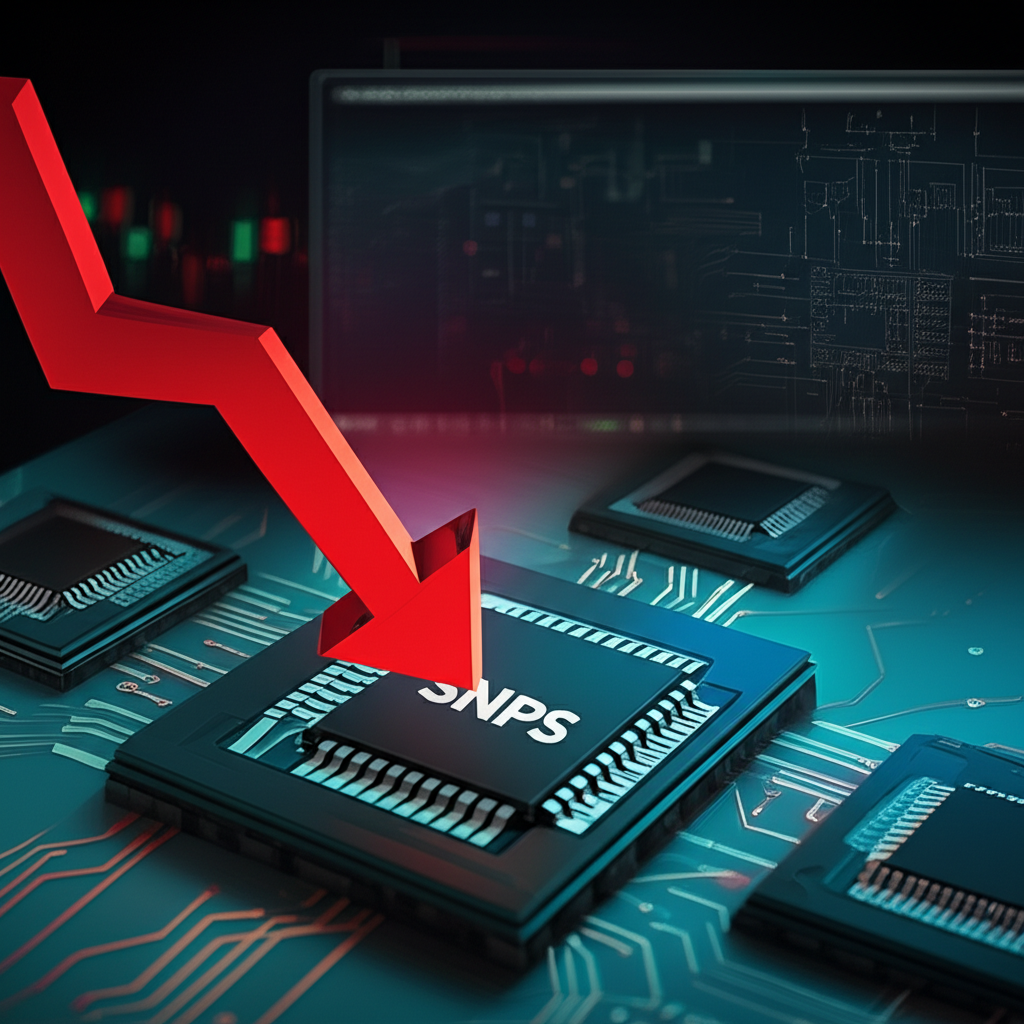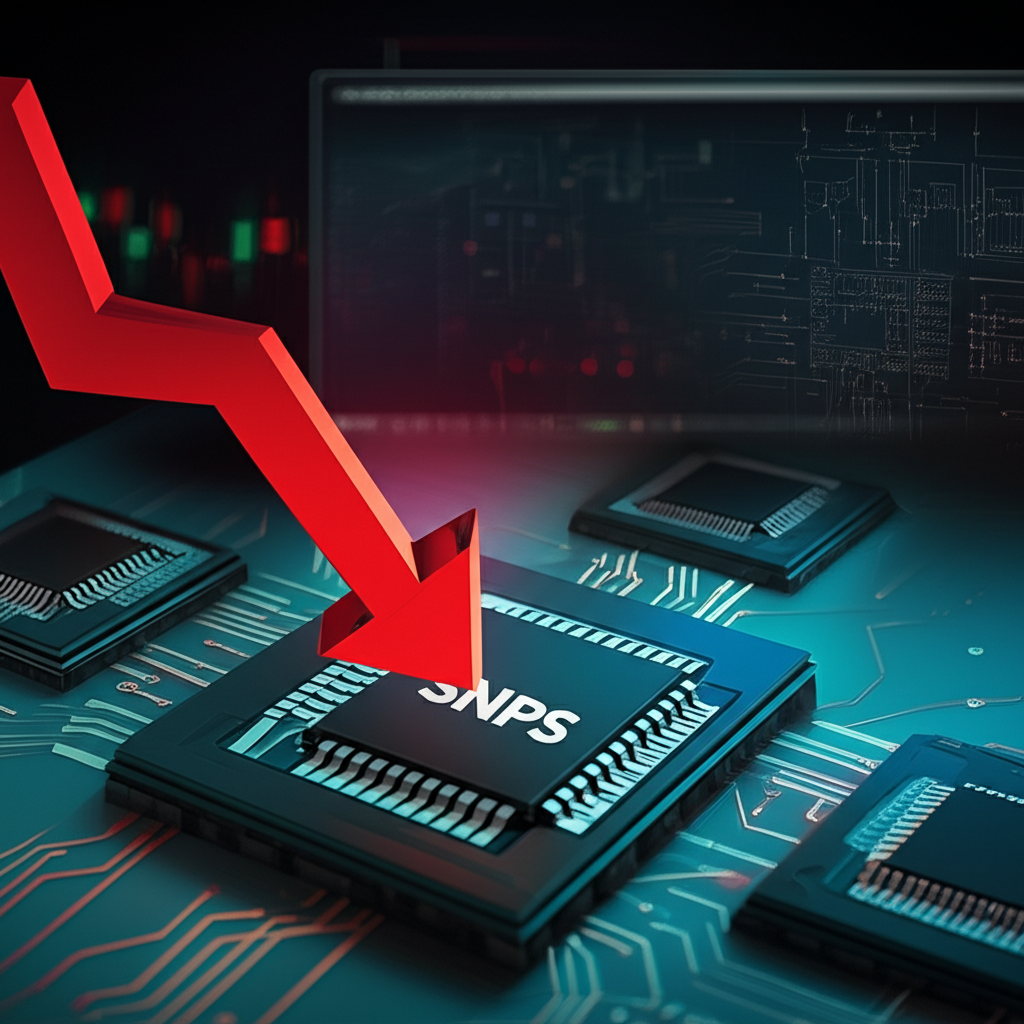Introduction: Understanding Synopsys (SNPS) Stock’s Recent Dip
Synopsys has long stood at the epicenter of innovation in the semiconductor industry, serving as a cornerstone provider of Electronic Design Automation (EDA) software and semiconductor intellectual property (IP). Its advanced tools are essential for designing and verifying the complex chips that power today’s most critical technologies—from smartphones and cloud infrastructure to artificial intelligence systems and autonomous vehicles. Despite this pivotal role, SNPS stock has recently faced notable downward pressure, sparking investor concern and prompting a closer look at the forces behind the decline. This analysis explores the specific catalysts driving the pullback, evaluates Synopsys’s underlying business strength, compares its position against key peers, and offers a balanced perspective on its long-term investment potential. By moving beyond headlines and market noise, we aim to deliver a clear, data-driven understanding of what’s truly influencing Synopsys’s share price.

Key Triggers: Why SNPS Stock Experienced Recent Declines
The recent softness in Synopsys’s share price is not the result of a single event, but rather a convergence of company-specific developments and broader macroeconomic trends. Understanding these interlocking factors is essential for investors seeking to determine whether the decline reflects temporary volatility or a more structural shift in sentiment.
Earnings Reports and Guidance Revisions
Quarterly earnings releases often serve as pivotal moments for stock performance, and Synopsys is no exception. While the company has consistently delivered strong financial results—such as robust revenue and earnings growth in its fiscal year 2023—the market’s reaction hinges not just on past performance but on forward-looking expectations. A recent dip in SNPS stock may have been triggered by cautious guidance, even if historical results were solid. For example, a report highlighting strong financials might have been accompanied by tempered revenue projections for the coming quarters. Such caution could stem from macroeconomic uncertainty, inventory rebalancing in end markets like consumer electronics, or softer near-term demand signals from key customers. Metrics such as year-over-year revenue growth, earnings per share (EPS), and backlog visibility are closely watched; even minor deviations from consensus estimates can lead to significant sell-offs, especially in high-growth tech stocks where valuations are sensitive to growth expectations.

Broader Market Headwinds and Industry-Specific Factors
Synopsys does not operate in a vacuum. Its stock is influenced by the broader technology sector and the cyclical nature of semiconductor capital spending. During periods of rising interest rates, inflation, or geopolitical instability, growth-oriented equities—including software and EDA names—often face valuation compression. Investors tend to rotate out of high-multiple stocks in favor of defensive or value-oriented assets, contributing to downward pressure on SNPS. Additionally, the semiconductor industry itself goes through cycles of expansion and contraction. Although long-term demand for advanced chips is rising—fueled by AI, data centers, and automotive innovation—short-term headwinds such as customer inventory corrections or supply chain disruptions can dampen near-term optimism. A slowdown in smartphone or PC sales, for instance, may create a cautious narrative across the tech sector, impacting investor sentiment even for companies like Synopsys that are well-positioned for future growth.
Analyst Sentiment and Investor Reaction
Analyst commentary carries considerable weight in shaping market perception. When a prominent research firm downgrades Synopsys or lowers its price target, it can trigger a wave of selling, particularly among institutional investors who rely on external research. These revisions may stem from updated macroeconomic forecasts, concerns about competitive dynamics with Cadence Design Systems, or a reassessment of valuation multiples in a higher-interest-rate environment. Once negative sentiment takes hold, it can become self-reinforcing—investors may sell not because of deteriorating fundamentals, but in anticipation of further declines. This behavioral aspect of markets means that short-term stock movements don’t always reflect the true health of the underlying business.

Synopsys Fundamentals: A Look Beyond the Stock Price
While the recent share price movement may raise concerns, a deeper examination of Synopsys’s business reveals a company with enduring competitive advantages and a resilient operating model. These fundamentals provide a crucial counterbalance to short-term market fluctuations.
Synopsys’s Business Model and Market Leadership
At its core, Synopsys enables the creation of the world’s most advanced semiconductors. Its solutions are embedded in nearly every major chip development cycle, making it an indispensable partner to semiconductor designers and system-on-chip (SoC) developers. The company’s offerings fall into three key segments:
* **Electronic Design Automation (EDA):** Synopsys provides a comprehensive suite of software tools used for chip design, simulation, verification, and physical implementation. Alongside Cadence, it dominates the EDA market, benefiting from a powerful duopoly structure. The complexity of modern chip design creates high switching costs and strong customer lock-in, giving Synopsys a durable competitive moat.
* **Semiconductor IP:** The company licenses pre-verified functional blocks—such as processor cores, interface IP (e.g., USB, PCIe), and security modules—that accelerate time-to-market for chipmakers. This business generates recurring revenue and complements its EDA offerings.
* **Software Integrity:** With cybersecurity becoming increasingly critical, Synopsys’s tools for code analysis, vulnerability detection, and compliance help organizations build secure software. This segment extends the company’s reach beyond silicon into broader enterprise software development.
Together, these businesses create a diversified yet synergistic revenue stream, underpinned by long-term customer contracts and a high proportion of recurring revenue—typically exceeding 85%. This predictability enhances financial stability and supports consistent reinvestment in innovation.
Financial Health and Growth Drivers
Synopsys has a track record of disciplined financial management and sustained growth. The company consistently delivers double-digit revenue growth, healthy operating margins, and strong free cash flow generation. Its ability to convert earnings into cash allows for strategic investments in R&D, targeted acquisitions, and shareholder returns through share repurchases and dividends.
Looking ahead, multiple secular trends are fueling long-term demand for Synopsys’s solutions. The explosive growth of **artificial intelligence**—particularly in training large language models and deploying AI at the edge—requires increasingly complex chip architectures, driving demand for advanced EDA tools and specialized IP. The rollout of **5G networks**, the rise of **autonomous and electric vehicles**, and the expansion of **cloud computing infrastructure** all depend on cutting-edge semiconductors, further entrenching Synopsys’s role in the innovation pipeline. These forces suggest that any near-term stock weakness may not reflect a decline in fundamental value, but rather a disconnect between market sentiment and long-term growth potential.

Comparative Analysis: SNPS vs. Industry Peers
To contextualize Synopsys’s performance, it’s valuable to compare it with its closest competitor, Cadence Design Systems (CDNS), as well as other major players in the semiconductor ecosystem.
Synopsys and Cadence effectively control the EDA market, forming a tightly contested duopoly. Both companies benefit from high barriers to entry, deep technical expertise, and long-standing relationships with leading chipmakers. As a result, they both command premium valuation multiples. However, differences in product focus, innovation cycles, and market positioning can lead to divergence in stock performance.
* **Stock Performance:** While SNPS and CDNS often move in tandem, there are periods when one outperforms the other. A recent dip in SNPS might have been more pronounced if Cadence issued stronger guidance or launched a breakthrough product in an emerging area like AI-optimized design tools.
* **Valuation Metrics:** Investors often compare P/E, P/S, and EV/EBITDA ratios to assess relative value. If Synopsys’s multiples have contracted more than Cadence’s following its recent decline, it could indicate a relative value opportunity—assuming growth prospects remain intact.
* **Growth Prospects:** Both companies are investing heavily in next-generation technologies such as AI-driven design automation, chiplets, and advanced packaging. Synopsys’s acquisitions—such as its purchase of Ansys (pending regulatory approval as of 2025)—could expand its simulation capabilities and broaden its total addressable market, potentially giving it an edge in system-level design.
Beyond EDA peers, comparing Synopsys to companies like NVIDIA, ASML, and TSMC provides additional context. While these firms operate in different parts of the semiconductor value chain—chip design, equipment manufacturing, and fabrication—collectively, their capital spending decisions influence demand for EDA tools. Synopsys typically exhibits lower revenue volatility than pure-play chipmakers due to its recurring revenue model, making it a relatively stable play on semiconductor innovation.
Valuation and Future Outlook for SNPS Stock
Assessing Synopsys’s current value requires balancing its growth potential against prevailing risks and market conditions.
Is SNPS Fairly Valued? A Look at Key Metrics
Following a stock price correction, investors often reassess valuation. Key metrics to consider include:
* **Price-to-Earnings (P/E) Ratio:** A lower P/E relative to its historical average or industry peers may suggest the stock is becoming more attractively priced. However, given Synopsys’s consistent growth and high margins, a premium valuation is often justified.
* **Price-to-Sales (P/S) Ratio:** This is particularly relevant for software-centric businesses. A declining P/S ratio after a price drop could signal improved value, especially if revenue growth remains strong.
* **PEG Ratio (P/E to Growth):** This adjusts the P/E ratio for expected earnings growth, offering a more nuanced view. A PEG below 1.0 may indicate undervaluation for a growth company.
If the recent decline was driven more by sentiment than fundamentals, SNPS’s valuation could now appear more reasonable—or even compelling—relative to its long-term earnings power. Comparing these metrics to Cadence and historical benchmarks helps determine whether the market is over-penalizing temporary headwinds.
Growth Catalysts and Potential Headwinds
Synopsys is positioned to benefit from several powerful **growth catalysts**:
* **AI-Driven Chip Complexity:** As AI models grow in scale, so does the need for specialized accelerators, pushing chip designers to adopt more sophisticated EDA tools.
* **Chiplets and Advanced Packaging:** With Moore’s Law slowing, chipmakers are turning to modular designs. Synopsys’s tools for 3D-IC and multi-die integration are critical in this new paradigm.
* **Automotive and IoT Expansion:** The surge in semiconductor content per vehicle—especially in EVs and ADAS systems—creates sustained demand for IP and design tools.
* **Strategic Acquisitions:** Synopsys has a proven track record of integrating acquisitions to expand its technology portfolio, such as its earlier purchases of Coverity and Black Duck in software security.
* **Recurring Revenue Model:** With over 85% of revenue from subscriptions and maintenance, the company enjoys high visibility and resilience during downturns.
Still, **risks remain**:
* A prolonged economic slowdown could delay or reduce R&D and capital spending by chipmakers.
* Geopolitical tensions—particularly U.S.-China trade restrictions—may limit access to certain markets or customers.
* The EDA space demands relentless innovation; falling behind in R&D could erode its competitive position.
* Intense competition with Cadence continues, especially in AI-enhanced design and system-level simulation.
Analyst Consensus and Price Targets
Despite recent volatility, the analyst community remains broadly positive on Synopsys. Most major firms maintain “Buy” or “Outperform” ratings, citing the company’s entrenched market position and exposure to structural growth trends. According to aggregated data from leading financial platforms, the average price target for SNPS suggests meaningful upside from current levels, with some estimates indicating double-digit percentage gains. While individual targets vary, the overall consensus reflects confidence in Synopsys’s ability to navigate near-term challenges and deliver long-term value.
Investment Considerations: Should You Buy SNPS Stock Now?
The decision to invest in Synopsys after a pullback depends on individual investment goals, time horizon, and risk appetite.
Long-Term vs. Short-Term Perspective
For **long-term investors**, the recent dip may represent a strategic entry point. Synopsys’s leadership in EDA, recurring revenue model, and alignment with megatrends like AI and electrification support a compelling growth story. Short-term volatility is common in high-growth tech stocks and does not necessarily indicate a deterioration in business quality. Investors focused on multi-year horizons should prioritize the company’s ability to sustain innovation and expand its addressable market over quarterly noise.
**Short-term traders**, meanwhile, may focus on technical signals, market momentum, and upcoming catalysts such as earnings reports or product launches. While this analysis emphasizes fundamentals, it’s acknowledged that near-term price action can be driven by sentiment, algorithmic trading, and macro headlines.
Risk Factors to Monitor
Even high-quality companies carry risks. Key areas to watch for Synopsys include:
* **Customer Concentration:** A small number of large semiconductor firms account for a significant portion of revenue. Any reduction in spending by these clients could impact near-term results.
* **R&D Execution:** The pace of innovation in chip design is accelerating. Synopsys must continue to invest heavily and deliver cutting-edge solutions to maintain its lead.
* **IP Protection:** The company’s business relies on a vast portfolio of patents and proprietary technology. Legal challenges or enforcement difficulties in certain regions could pose risks.
* **Industry Cyclicality:** While less volatile than chip manufacturers, Synopsys’s revenue is still tied to semiconductor capex cycles, which can experience downturns.
A Brief Technical Analysis Overview
From a technical standpoint, SNPS may be approaching key support levels following its recent decline. The 200-day moving average and prior consolidation zones—potentially in the $500–$520 range—could act as a floor, attracting buyer interest. A sustained move above resistance levels around $550–$570 would signal renewed bullish momentum. While technical analysis should not drive investment decisions in isolation, it can help identify potential entry points and gauge market sentiment when combined with fundamental insights.
Conclusion: Navigating Synopsys’s Stock Volatility
The recent pullback in Synopsys (SNPS) stock reflects a mix of cautious guidance, macroeconomic pressures, and shifts in investor sentiment—factors that have weighed on many tech stocks. Yet beneath the surface, the company remains a leader in a mission-critical industry, with a dominant position in EDA, strong financials, and exposure to powerful long-term trends. Its recurring revenue model, innovation pipeline, and strategic acquisitions underscore its resilience and growth potential.
For investors, the key is to distinguish between temporary market fluctuations and lasting changes to the business. While volatility is inevitable, Synopsys’s fundamental strengths suggest that current price levels may offer a favorable opportunity for long-term positioning. Ongoing monitoring of earnings trends, competitive dynamics, and macroeconomic conditions will be essential. Ultimately, Synopsys continues to play a foundational role in shaping the future of technology—making it a stock worth watching closely.
Frequently Asked Questions about SNPS Stock
1. Is SNPS a good stock to buy now after its recent decline?
Whether SNPS is a good buy depends on your investment strategy and risk tolerance. While recent declines might offer a more attractive entry point, it’s crucial to assess your long-term goals and the company’s fundamentals. Many analysts maintain a positive long-term outlook due to Synopsys’s market leadership and exposure to secular tech trends.
2. What were the primary reasons for Synopsys (SNPS) stock’s recent downturn?
The primary reasons often include:
- Weaker-than-expected forward guidance in recent earnings reports.
- Broader market headwinds affecting the technology sector, such as rising interest rates or economic slowdown fears.
- Analyst downgrades or shifts in investor sentiment.
3. How do Synopsys’s (SNPS) fundamentals look despite the stock drop?
Despite recent stock volatility, Synopsys’s fundamentals generally remain strong. The company holds a dominant position in the essential EDA and semiconductor IP markets, boasts a robust recurring revenue model, generates healthy profit margins, and benefits from long-term growth drivers like AI, 5G, and automotive electronics.
4. What is the future outlook for Synopsys (SNPS) stock and its industry?
The future outlook for Synopsys and the EDA industry is largely positive. The increasing complexity of chip design, driven by emerging technologies, ensures continued demand for Synopsys’s essential tools and IP. While industry cycles exist, the long-term trend for semiconductors remains upward, directly benefiting Synopsys.
5. Has Synopsys (SNPS) stock shown signs of recovery in the past?
Like many technology growth stocks, Synopsys has experienced periods of volatility and subsequent recovery throughout its history. Its ability to rebound is typically tied to its strong fundamentals, consistent innovation, and the overall health of the semiconductor market. Past performance is not indicative of future results, but it highlights the company’s resilience.
6. How does SNPS’s current valuation compare to its competitors in the EDA market?
Synopsys typically trades at a premium valuation alongside its primary competitor, Cadence Design Systems (CDNS), reflecting their duopolistic market position and critical technology. After a decline, its valuation metrics (P/E, P/S) might become more aligned with or even slightly below historical averages or peer comparisons, potentially signaling a more attractive entry point.
7. What are the main risks associated with investing in Synopsys (SNPS) stock?
Key risks include:
- Reliance on a few large customers.
- The high intensity of R&D required to stay competitive.
- Potential impacts from geopolitical tensions or trade restrictions.
- The cyclical nature of the broader semiconductor industry.
- Challenges in protecting intellectual property.
8. Will Synopsys (SNPS) stock go back up to its previous highs?
While no stock is guaranteed to return to previous highs, Synopsys’s strong business model and long-term growth drivers suggest significant potential for recovery and continued appreciation. Its ability to innovate and benefit from key technology trends provides a solid foundation for future growth.
9. Where can I find Synopsys (SNPS) share price news and earnings reports?
You can find official earnings reports and investor news directly on the Synopsys Investor Relations website. Reputable financial news outlets like Bloomberg, Reuters, The Wall Street Journal, and Yahoo Finance also provide real-time share price data and related news.
10. What is the analyst consensus for Synopsys (SNPS) stock’s future performance?
The general analyst consensus for Synopsys typically leans positive, with many firms issuing “Buy” or “Outperform” ratings. Price targets often suggest potential upside from current levels, though these targets are subject to change based on market conditions and company performance updates.

留言